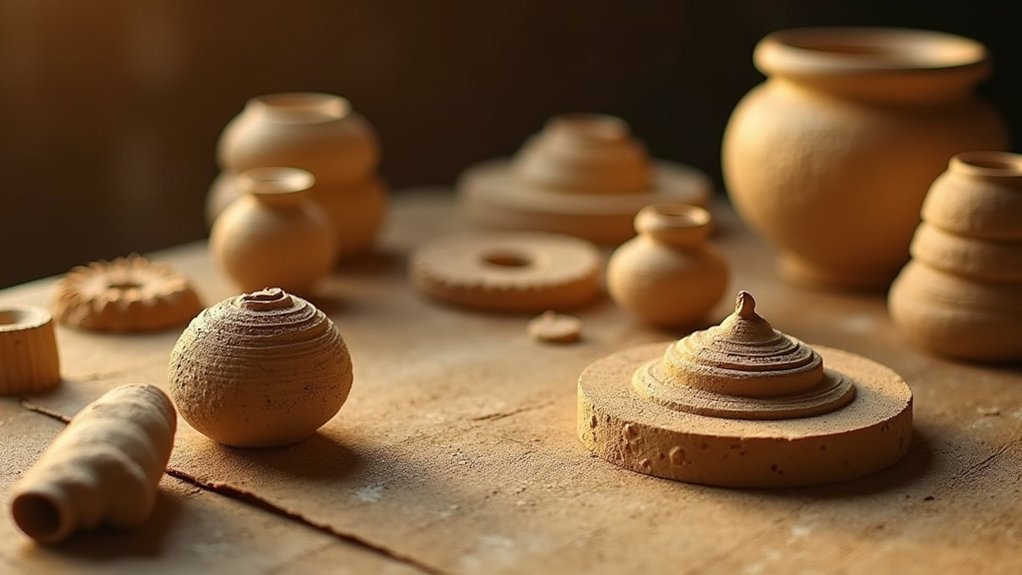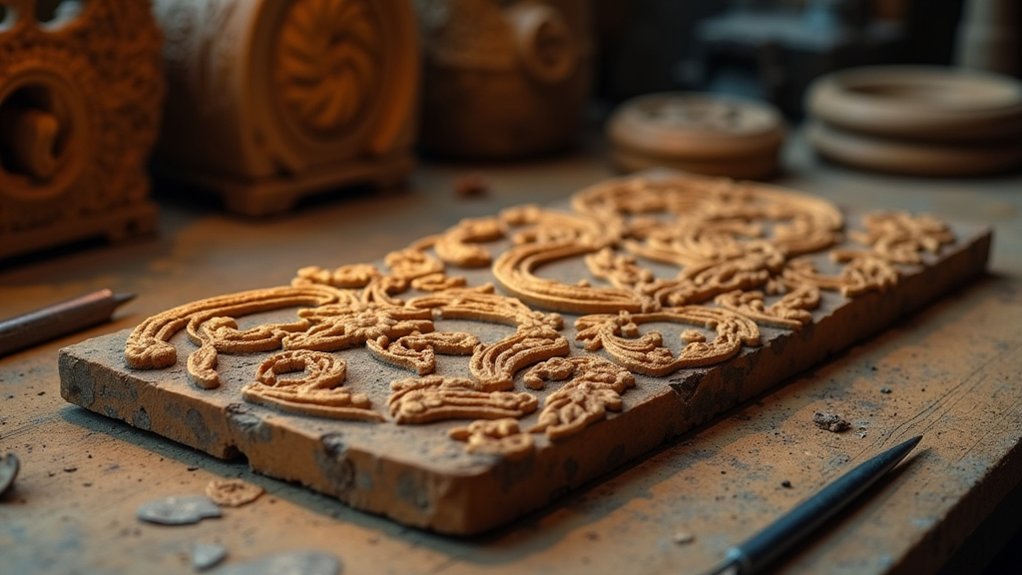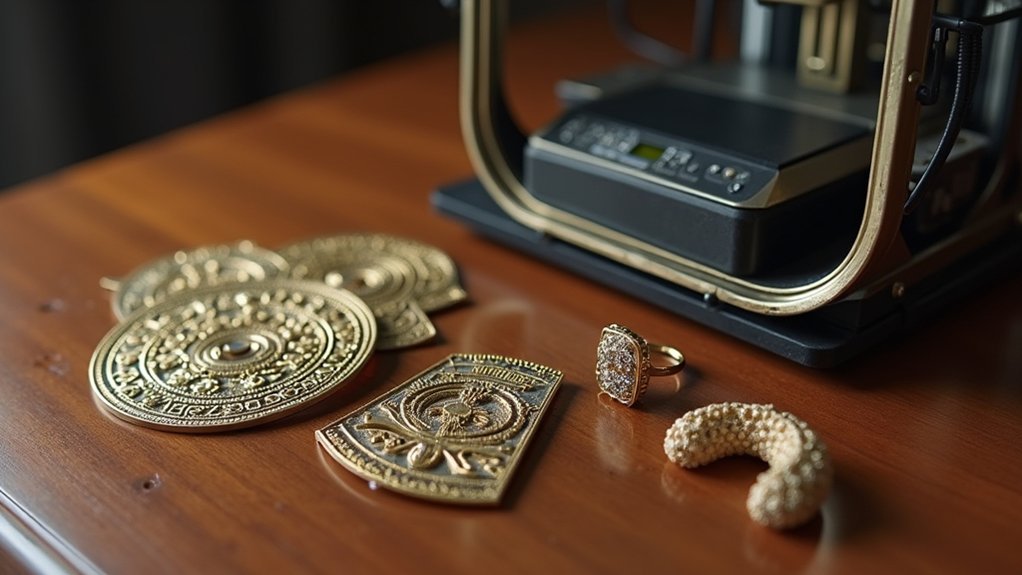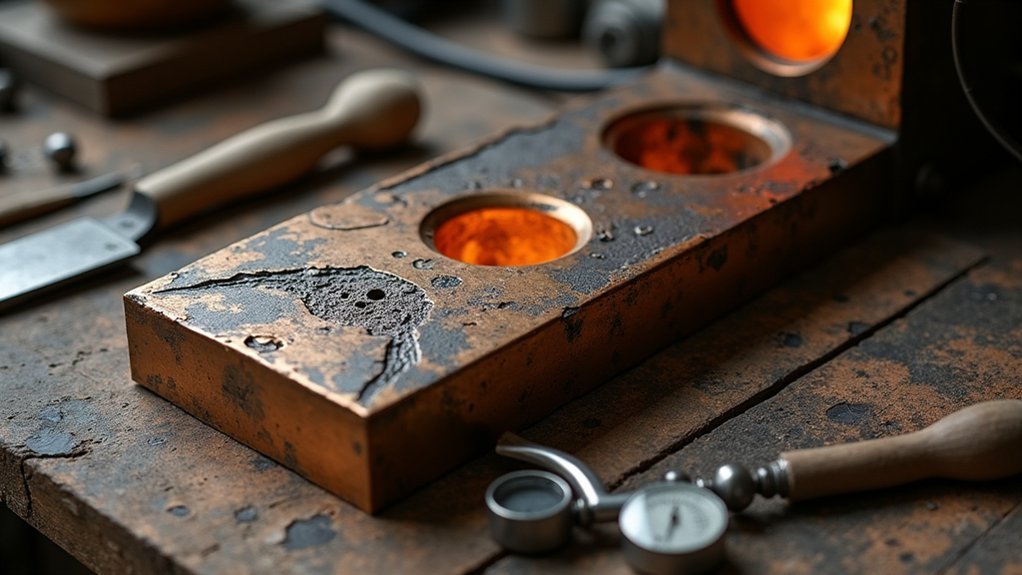You’ll discover that casting methods evolved from ancient Mesopotamian lost wax techniques around 3000 BC to today’s sophisticated jewelry production. Ancient civilizations pioneered bronze casting for ceremonial pieces, while medieval craftsmen created monumental gateways and the first cannons. The Industrial Revolution introduced centrifugal casting and die-casting machines, revolutionizing precision. Today’s artisans blend traditional lost wax methods with 3D printing and vacuum-assisted equipment, with companies casting thousands of intricate pieces daily using both ancient wisdom and modern innovation.
The Birth of Lost Wax Casting in Ancient Civilizations

When you examine the archaeological record from around 3000 BC, you’ll discover that ancient artisans revolutionized metalworking through the lost wax casting technique. This innovative lost wax process enabled craftsmen to create intricate metal objects by melting away wax models after forming molds around them.
Ancient civilizations in Mesopotamia pioneered this metalworking technique, producing detailed bronze artifacts, sculptures, and ceremonial pieces that demonstrated extraordinary skill. You’ll find this method’s adaptability and precision made it invaluable across cultures, spreading to India and China where artisans would manufacture items like coins and ritual vessels.
The technique markedly advanced artistic expression in these early societies, allowing unprecedented detail and complexity in metalwork that established the foundation for modern casting methods used today.
Medieval Craftsmanship and Renaissance Innovation in Metal Casting
As medieval Europe emerged from the early centuries, metalworkers transformed ancient casting techniques into sophisticated craftsmanship that would define an entire era.
You’ll find that Charlemagne’s revival of bronze casting in the 7th century sparked the creation of monumental bronze gateways, showcasing remarkable medieval craftsmanship.
Cathedral construction drove innovations in casting techniques as religious institutions demanded intricate designs for architectural elements.
In 1313, a Ghent monk revolutionized foundry technology by creating the first cast cannon using bell-making expertise.
Renaissance innovation peaked when Vannoccio Biringuccio published *De Le Pirotechnia* in 1473, providing systematic understanding of metal casting processes.
This period’s increased demand for artistic metalwork established foundational principles that shaped modern foundry practices you recognize today.
Traditional Jewelry Casting Techniques Across Cultures

While Renaissance innovations transformed European foundries, jewelry casting had already flourished across diverse cultures for millennia, each developing distinctive techniques that reflected their artistic heritage and metallurgical expertise.
You’ll discover that ancient civilizations mastered sophisticated casting methods long before Vannoccio Biringuccio documented practices in *De la Pirotechnia*:
- Egyptian and Mesopotamian mastery – The lost wax technique emerged around 4000 BC, enabling intricate jewelry designs that showcased remarkable detail and craftsmanship.
- Greek innovation – Ancient Greeks developed sand casting, using sand molds to create complex pieces that embodied their distinctive artistic heritage.
- Asian advancement – Indian artisans mass-produced coins by 1000 BC, while China’s Bronze Age saw the lost wax technique producing ceremonial items of cultural significance.
These traditional techniques laid the foundation for modern jewelry casting, demonstrating how metallurgical knowledge transcended geographical boundaries and influenced contemporary practices.
Industrial Revolution’s Impact on Precious Metal Casting Methods
The Industrial Revolution transformed precious metal casting from artisanal craft to mechanized production, introducing breakthrough technologies that would redefine the industry’s capabilities.
You’ll find that A.G. Eckhart’s 1809 centrifugal casting patent dramatically improved uniformity in metal products by eliminating inconsistencies.
When S. Jarvis Adams Co. developed the first commercial molding machine in 1837, you’d witness unprecedented speed and efficiency in precious metal casting processes.
The Bessemer Converter’s 1856 introduction revolutionized steel production by removing impurities, directly impacting casting technology standards.
You’d see die-casting machines emerge, enabling intricate precious metal designs previously impossible through traditional methods.
The 20th century brought electric induction furnaces, which you’d recognize as game-changers for precision and consistency in industrial precious metal casting operations.
Modern Technology Meets Ancient Artistry in Contemporary Jewelry Making

Building upon these industrial breakthroughs, today’s jewelry makers have created an extraordinary synthesis where millennia-old techniques flourish alongside cutting-edge technology.
You’ll find that lost wax casting, dating back to 4000 BC, remains fundamental to contemporary jewelry creation, but now it’s enhanced by remarkable innovations.
Modern technology has revolutionized how you approach ancient casting techniques through:
- Advanced design software like CounterSketch and Matrix that enable customized, intricate designs
- Sophisticated casting equipment including vacuum-assisted and centrifugal machines for enhanced efficiency and precision
- 3D printing and resin casting technologies that maintain detailed qualities while enabling mass production
You’re witnessing artistry and craftsmanship evolve dramatically.
Companies like Stuller demonstrate this fusion perfectly, operating 30 ovens and casting up to 10,000 pieces daily, proving that jewelry making successfully balances traditional methods with contemporary demands.
Frequently Asked Questions
What Techniques Were Used in Ancient Casting?
You’d use lost wax casting, melting wax models from molds, stone molds for copper and gold, sand casting with compressed sand and clay, and bronze casting for stronger, more durable metal objects.
What Is the History of the Casting Process?
You’ll find casting began around 4000 BC with gold and copper. Lost wax techniques emerged in 3000 BC Mesopotamia. Bronze casting dominated ancient Egypt, while medieval religious projects and Industrial Revolution innovations transformed modern processes.
What Are the 4 Main Types of Casting?
You’ll find four main casting types: sand casting for versatility and cost-effectiveness, investment casting for intricate precision parts, die casting for mass-produced components, and centrifugal casting for strong cylindrical parts.
What Is the Oldest Known Casting?
You’ll find the oldest known metal casting dates back to around 4000 BC, featuring gold due to its malleability. However, the earliest surviving casting artifact you can study is a copper frog from 3200 BC.
In Summary
You’ve witnessed casting evolve from ancient lost wax techniques to today’s high-tech methods, yet the fundamental artistry remains unchanged. Whether you’re examining Bronze Age artifacts or contemporary jewelry, you’ll find the same dedication to craftsmanship spanning millennia. Modern technology hasn’t replaced traditional skills—it’s enhanced them. As you explore casting today, you’re participating in humanity’s oldest manufacturing traditions, where ancient wisdom meets cutting-edge innovation in every molten pour.





Leave a Reply